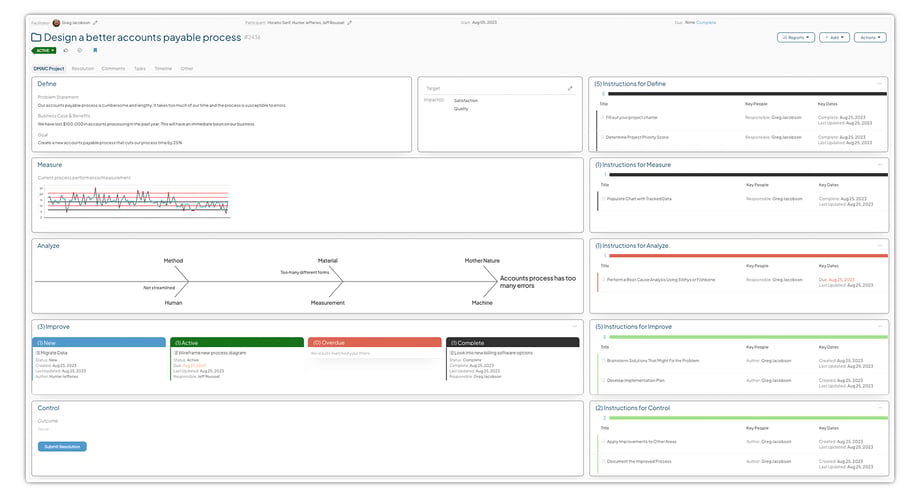 DMAIC is a structured, customer-focused, data-driven approach to problem-solving. The acronym stands for:
DMAIC is a structured, customer-focused, data-driven approach to problem-solving. The acronym stands for:
1- Define
2- Measure
3- Analyze
4- Improve
5- Control
It is often associated with the Lean Six Sigma business methodology, but it can be valuable for any organization.
The Purpose of DMAIC
The goal of the DMAIC approach is to bring structure to problem-solving. When organizations consistently use the model, employees become better at addressing process issues and finding an effective solution. Cross-functional collaboration is enhanced, and change becomes easier to control. Teams can use DMAIC to implement a new process or improve an existing process. Because change is based on collected data, it is possible to determine whether business results are improved and by what measure.
DMAIC is popular because it is repeatable and easy to understand. It provides quantifiable evidence that improvements are working. For example, a tire manufacturer in Portugal was able to save more than $200,000 a year using DMAIC to address waste in the rubber extrusion process.
Let's take a deeper dive into each of the five steps of DMAIC.

Define
During the Define phase, high-impact opportunities for improvement are selected.
The critical steps during Define are:
- Identify the opportunity for improvement
- Delineate the scope of the project
- Develop customer requirements
- Estimate project impact
- Identify all stakeholders
- Form the team
Resist the temptation to rush through this step and start experimenting with change.
Measure
During the Measure phase, existing processes are documented, data is collected, and a baseline upon which to improve is established.
Critical activities include:
- Develop the methods of data collection
- Identify input, processes, and output indicators
- Gather and analyze current state data
- Complete failure modes and effects analysis
Consider control charts to map process behavior and identify trends.
Analyze
The Analyze phase aims to identify and test the root causes of problems and ensure that improvement is focused on them.
- Develop a problem statement
- Complete a root cause analysis
- Implement process control
- Design measurable improvement experiments
- Develop a plan for improvement
Many organizations use value stream mapping and the 5 Whys problem-solving technique during this stage.
Improve
Now you'll start to implement the changes that the study and measurement have prescribed.
The following activities are typical:
- Generate and discuss solution ideas
- Determine expected solution benefits
- Develop revised process maps and plans
- Define a pilot solution and plan
- Communicate solutions to all stakeholders
Improvement management software plays an integral part at this stage. Leaders make assignments and track activities as the project progresses. Email and in-app alerts help ensure that no tasks are missed. Executives and managers can follow the progress of all DMAIC projects using dashboards and charts.
Control
It's time to ensure that the win will be lasting and that results will be measured over the long run.
Your team will:
- Verify reduction in failures due to the targeted cause
- Determine if additional improvements are required to achieve the goal
- Identify and document the new Standard work
- Integrate and share the lessons learned
If you have improvement technology in place, you can set up your measurement activities to ensure that key performance indicators continue to show the expected results.
How to Use DMAIC
If you'd like to put the DMAIC model to work in your organization, the following implementation steps are useful:
Step 1: Training
Start by educating your team about the DMAIC approach and how it will be used in your organization. Emphasize the data collection aspects of the model.
Step 2: Support and Tools
Many Lean Six Sigma tools can be used during a DMAIC cycle, including control charts, the 5 Whys, fishbone diagrams, and Catchball. Determine which tools your team will use and how they will be documented and shared. Improvement management software is the ideal home for all DMAIC related documents and progress notes.
Step 3: Provide Examples
It helps to provide your team members with examples of the types of existing or new processes within your organization that are good targets for the DMAIC approach. Once they understand how it can be used, make sure there is an easy way for employees to suggest process improvement opportunities.
Step 4: Conduct a Pilot Project
Once you've completed these steps, you're ready to give it a try! Choose a simple project to begin with, preferably one that involves people from multiple teams. Pay attention to each step in the cycle and be sure that each is complete before moving to the next.
DMAIC takes discipline, but once your team gets comfortable with the approach, it will become second nature, enabling them to create more positive change quickly and efficiently.



Add a Comment